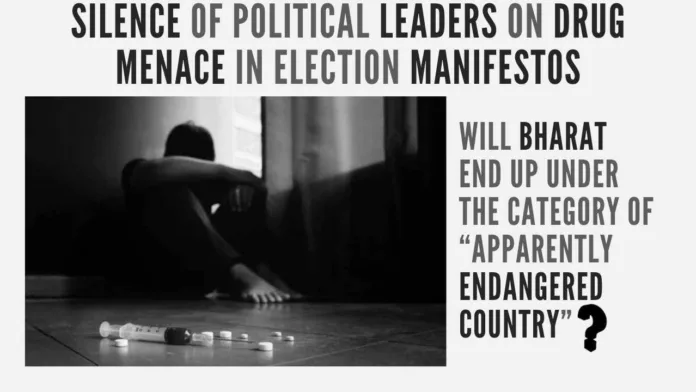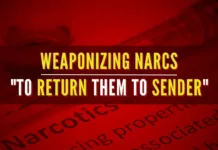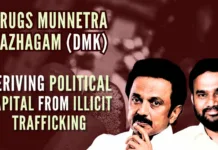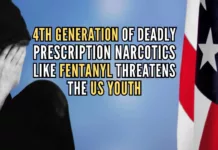
Youth drug abuse: Young people at the top of the drug consumption chain
India is a very youthful country and more than 50% of its population are below the age of 25 and more than 65% below the age of 35. Unfortunately, a large percentage of this population is unemployed and feels marginalized in terms of access to opportunities, representation, and participation. To overcome challenges and problems plaguing them, the country’s youth population has turned to the consumption of both licit and illicit substances, in an extensive way. As a result of the markedly high levels of drug consumption in this age group, many youths indulge themselves recklessly in drugs and substance abuse for all sorts of reasons. They range from dysfunctional families, peer influence, availability of alcohol and drugs, the influence of social media, unemployment, and stress to mention a few. The reason for this is that young people are prone to a media culture that portrays drug abuse as fashionable.
Drug trafficking organizations are gaining ground as the country is increasingly being used as a major transit hub for narcotics, as well as a lucrative destination. Recent developments in India suggest that increased drug trafficking throughout the region has led to the criminalization or capture of state institutions by sophisticated drug-trafficking organizations (DTOs) with financial capacities that outshine those of entire countries. Various factors have been attributed to influencing drug and substance abuse among the youths but these factors cannot be generalized to be absolute.
The continued consumption of drugs eventually leads to a condition referred to in medical circles as pathological drug dependence. When an individual reaches such a state, they become unable to desist from consuming the drug even when it becomes apparent that the drugs might be causing considerable health damage to them. The negative consequences arising as a result of drug abuse are well documented, whether it is the effects on the individual or society. If intervention measures are not put in place, the fate of future generations is at stake.
The spike in the rate of drug abuse has been witnessed in almost every part of the globe. The drug scourge has not spared any country: drug and substance abuse is very much a challenge and a devastating problem, for every country. Studies have revealed that drugs and substance misuse are influenced by a complex, interacting network of sociological, psychological, and biological variables. When young people abuse drugs, a myriad of reasons is given as justification for indulging in such behaviour at such a young age. These reasons range from dealing with anxiety and uncertainties of becoming adults to dealing with everyday challenges and problems. In addition to this, factors that might be beyond an individual’s control such as personality, genetics as well as the environment are also fundamental determinants of drug abuse.
Despite such a grave threat to the country, all political party manifestos, scrupulously avoid any mention of the drug menace, drug trafficking, and narco-terrorism problems affecting the country. It appears to be a studied avoidance, in order not to ruffle the feathers of a particular community, which has a lion’s share in the illicit drug business.
Such negligence and apathy of political parties could push the country into the category of an “apparently endangered country”.
This is a cause for worry for many parents, institutions, local authorities, and the government as they grapple with an answer to this problem. The youth are a special risk group when it comes to drug abuse. The population of this group in our country with inadequacy of social services, educational and employment opportunities, and recreational facilities bears the brunt of this problem. The seriousness of the drug abuse problem in our society cannot be underestimated and the disturbing statistics are an outcry for action to be taken as soon as possible.
Drug and substance abuse threatens and tends to demotivate the students in learning and subsequently ruin school-going children, that the government intends to rely on, in driving the economy to the next level. Despite the overwhelming intervention strategies by the government, religious organizations, non-state actors, and many other keen stakeholders to curb the problem of drug and substance abuse especially among the youth, the number of school-going youth being sucked into drug abuse seems to be escalating day by day. Of major concern is that children are being targeted as the new emerging market for the drug industry. If left unaddressed, the escalating rate of drug and substance abuse puts the country at risk of losing generations as well as slowing down the developmental process owing to the diversion of resources to address increased healthcare needs among the youth, the increased cost of policing, which compounded will go a long way in frustrating the attainment of the UN Sustainable Development Goals (SDGs).
At present a burgeoning relationship between trafficking in narcotics and terrorism exists. The transnational nature and diversity of these crimes enable criminal networks to work alongside terrorist groups with catastrophic consequences. Drug trafficking and terrorism, especially, are severe threats to domestic and global stability and security. While neither of these perils is new, they have developed into multidimensional, global, and exceptionally complex threats. Terrorism essentially requires financing: finances with which to pay operatives, purchase weapons, for housing, travel, surveillance, and plan operations. Narcotics are easy to acquire and market, with immense profits and the money is easily transferrable. Because these two groups inhabit and operate in largely the same spaces, traffickers of narcotics and terrorists function jointly.
The narco-terror nexus, together with the illicit economy should have been a crucial election campaign topic. Specifically, the origins of terrorist perpetrators, the severity of terrorist attacks, and the frequency of terrorist incidents, impact citizens’ emotions and voting calculations. For example, in November 2023 in the USA, authorities were hunting for whoever sent suspicious letters — including some containing fentanyl — to elections offices in at least five states, thereby delaying the counting of ballots in some local elections. The letters were sent to election offices in the presidential battlegrounds of Georgia and Nevada, as well as California, Oregon, and Washington, with some being intercepted before they arrived. Four of the letters contained Fentanyl, according to the FBI and U.S. Postal Inspection Service. Washington Secretary of State Steve Hobbs called the incidents in his state “acts of terrorism to threaten our elections.”
The fact that all political parties have conspicuously avoided mentioning the threat to the nation from narco-terrorism, is a very grave failure. The need to regulate uncontrolled, undisclosed, and opaque political finance was identified by the Global Commission on Elections, Democracy, and Security as a major challenge to the integrity of elections in emerging and mature democracies alike. The Global Commission argued that poorly regulated political finance can diminish political equality, provide opportunities for organized crime to purchase political influence, and undermine public confidence in elections. The penetration of illicit drug money into politics poses a particular danger to democracy and its institutions. This is palpably evident along the Latin American drug-trafficking corridor stretching from the Andean region to Mexico, where drug money has infiltrated political life and elections.
All Indian political parties by not mentioning the narco-terror threat to the country and what they propose to do to root out the evil, in their Election Manifestos, are pushing the country deliberately into the category of “apparently endangered country”.
Note:
1. Text in Blue points to additional data on the topic.
2. The views expressed here are those of the author and do not necessarily represent or reflect the views of PGurus.
For all the latest updates, download PGurus App.
- Weaponizing Narcs – To Return them to Sender - April 15, 2024
- Silence of political leaders on drug menace in election manifestos – Will Bharat end up under the category of “apparently endangered country”? - April 6, 2024
- Is religious engagement of bulk voters derailing Indian democratic election process? - April 3, 2024










